Harris C.M., Piersol A.G. Harris Shock and vibration handbook
Подождите немного. Документ загружается.

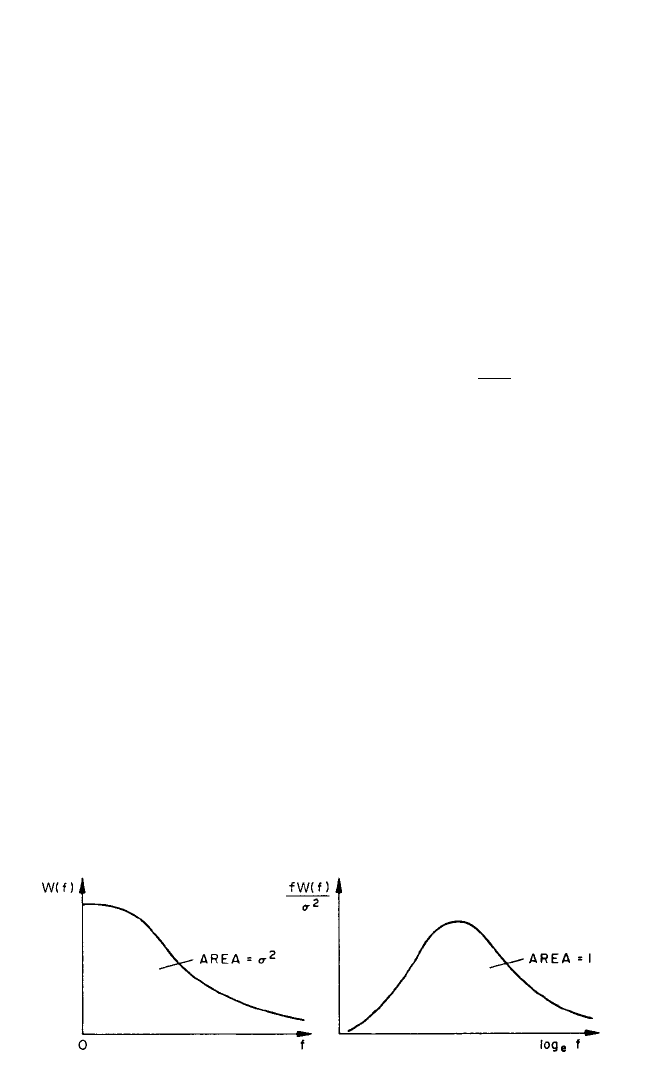
ticularly in the lower region, when the air flow meets an abrupt change in surface
roughness or terrain contour. A sudden increase in roughness reduces the wind
speed near the ground while a hill accelerates the flow over its crest.
The mean wind profiles are useful when predicting the wind speed at a particular
site. The gradient wind speed is estimated using data registered by the nearest mete-
orological stations at their standard height, which is usually 33 ft (10 meters). The
mean wind velocity generally depends on the period over which the wind speed is
averaged. Periods from 10 to 60 minutes appear adequate for engineering consider-
ations and usually yield reasonably steady mean values. The same duration is suit-
able to define the fluctuating wind component.
Fluctuating Components of the Wind. The fluctuating components of the wind
change with height less than the mean wind and are random both in time and space.
The random nature of the wind requires the application of statistical concepts (see
Chap. 11). The basic statistical characteristics of the velocity fluctuations are the
intensity of turbulence, the power spectral density (power spectrum), the correlation
between velocities at different points, and the probability distribution.
The intensity of turbulence is defined as σ
v
/
¯
V
z
, where σ
v
=
v
2
(
t
)
is the root-mean-
square (rms) fluctuation in the longitudinal direction.The intensity of the lateral and
vertical fluctuations can be described similarly. For wind, the intensity of turbulence
is between 5 and 25 percent. The magnitude σ
v
also defines the probability distribu-
tion of the fluctuations which may be assumed to be Gaussian (normal).
The energy of turbulent fluctuations (gustiness) is distributed over a range of fre-
quencies. This distribution of energy with frequency f can be described by the spec-
trum of turbulence (power spectral density) W
v
(f ). The relationship between the
spectrum and the variance is
∞
0
W
v
(f ) df =σ
v
2
which leads to another form of the spectrum known as the logarithmic spectrum
fW
v
(f )/σ
v
2
. This form of the spectrum is dimensionless and preserves the relative
contributions to the variance at different frequencies represented on a logarithmic
scale; and its integral is
∞
0
d ln f = 1
The two forms of spectra are sketched in Fig. 29.21. A generalization of wind
spectra for different wind velocities is possible if the frequency scale is so modified
fW
v
(f )
σ
v
2
29.26 CHAPTER TWENTY-NINE, PART II
FIGURE 29.21 Two different ways of presenting power spectral densities.
8434_Harris_29_b.qxd 09/20/2001 11:44 AM Page 29.26
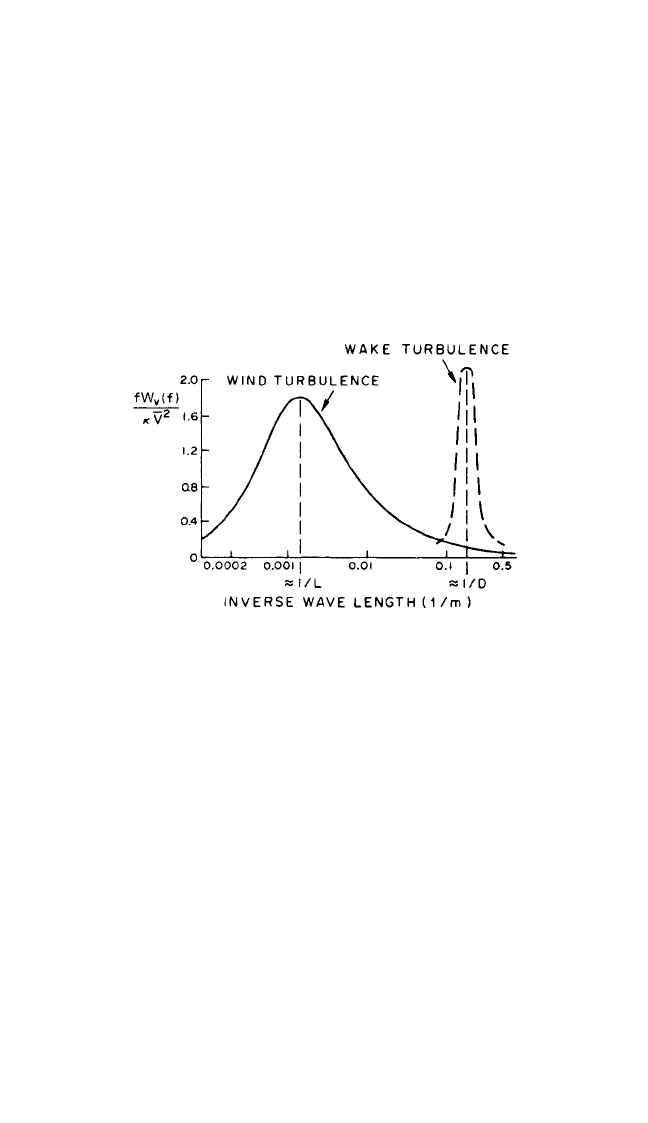
that it too is dimensionless. The ratio f/
¯
V is the so-called inverse wavelength related
to the “size” of atmospheric eddies. This may be expressed as a ratio to a represen-
tative length scale L, such as the wavelength of the eddies at the peak of the spec-
trum. The dimensionless frequency or inverse wavelength may now be written
¯
f = fL/
¯
V
Under certain circumstances this relationship is also known as the Strouhal number
or the reduced frequency.
It is generally found that while the length scale L in the oncoming flow corre-
sponds to that of the turbulence itself (this in the natural wind is of the order of
thousands of feet), in the wake the governing length scale is of the same order as the
diameter of the body D. This is illustrated in Fig. 29.22.
VIBRATION OF STRUCTURES INDUCED BY WIND 29.27
FIGURE 29.22 Universal spectrum of horizontal gusti-
ness in strong winds and example of spectrum of fluctua-
tions in wake.
The spectrum of horizontal gustiness in strong winds is largely independent of
height above the ground, is proportional to both the surface drag coefficient κ and
the square of the mean velocity at the standard height of 10 meters,
¯
V
10
, and can be
represented, with some approximations, as
6,7
W
v
(f ) = 4κ
¯
V
10
2
(29.25)
in which f = frequency, Hz,
¯
f = fL/
¯
V
10
where L = scale length ≈4000 ft, and κ is given
in Fig. 29.20. This spectrum is shown in Fig. 29.22.
The variance of the velocity fluctuations is
σ
v
2
=
∞
0
W
v
(f ) df = 6.68κ
¯
V
10
2
(29.26)
It can be seen from Eqs. (29.25) and (29.26) that large velocity fluctuations can be
expected in rough terrain where coefficient κ is large.
The spatial correlation of wind speeds at two different stations is described by the
coherence function (see Chap. 22),
L/
¯
V
10
(2 +
¯
f
2
)
5
⁄6
8434_Harris_29_b.qxd 09/20/2001 11:44 AM Page 29.27

γ
12
2
(f ) =≤1 (29.27)
where W
12
(f ) = cross spectrum (generally complex) between stations 1 and 2; W
1
(f)
and W
2
(f ) are power spectra of the two stations. The coherence function depends
primarily on the parameter ∆zf/
¯
V, where ∆z = separation and
¯
V =
1
⁄2(
¯
V
1
+
¯
V
2
) is the
average wind speed. A suitable approximate function is
C
o
h
e
re
n
ce
= e
−c(∆zf/
¯
V)
where c is a constant having a value of approximately 7 for vertical separation and
approximately 15 for horizontal separation. Coherence decreases with both separa-
tion and frequency. A more detailed discussion of wind characteristics is given in
Refs. 1 and 7.
EXCITATION DUE TO TURBULENCE
When a structure is exposed to the effects of wind, the fluctuating wind velocity
translates into fluctuating pressures, which in turn produce a time-variable response
(deflection) of the structure. This response is random and represents the basic type
of wind-induced oscillations. The theoretical prediction of this oscillation is rather
complex but can be reduced to a simple procedure suitable for design purposes. The
discussion of the oscillation is therefore presented in two parts. In the first part, the
basic theoretical steps are outlined. In the second part, the design procedure known
as the gust-factor approach is given in more detail.
FUNDAMENTALS OF RESPONSE PREDICTION
If the area A of the structure exposed to wind is small relative to the significant tur-
bulent eddies, the so-called quasi-steady theory for turbulence can be used to esti-
mate aerodynamic forces. In the drag direction, the drag force
D(t) =ρC
D
AV
2
(t)
=ρC
D
A
¯
V
2
1 + 2 +
where ρ=air density (normally equal to 0.0024 slugs/ft
3
), and C
D
= drag coefficient.
If v(t) <<
¯
V, the squared term is ignored. The spectra of the fluctuating drag and
velocity are then related as
= 4 (29.28)
where the mean drag (static component of the drag) is
¯
D =ρC
D
A
¯
V
2
(29.29)
and W
v
(f) is given by Eq. (29.25).
1
2
W
v
(f )
¯
V
2
W
D
(f )
¯
D
2
v
2
(t)
¯
V
2
v(t)
¯
V
1
2
1
2
|W
12
(f )|
2
W
1
(f )W
2
(f )
29.28 CHAPTER TWENTY-NINE, PART II
8434_Harris_29_b.qxd 09/20/2001 11:44 AM Page 29.28
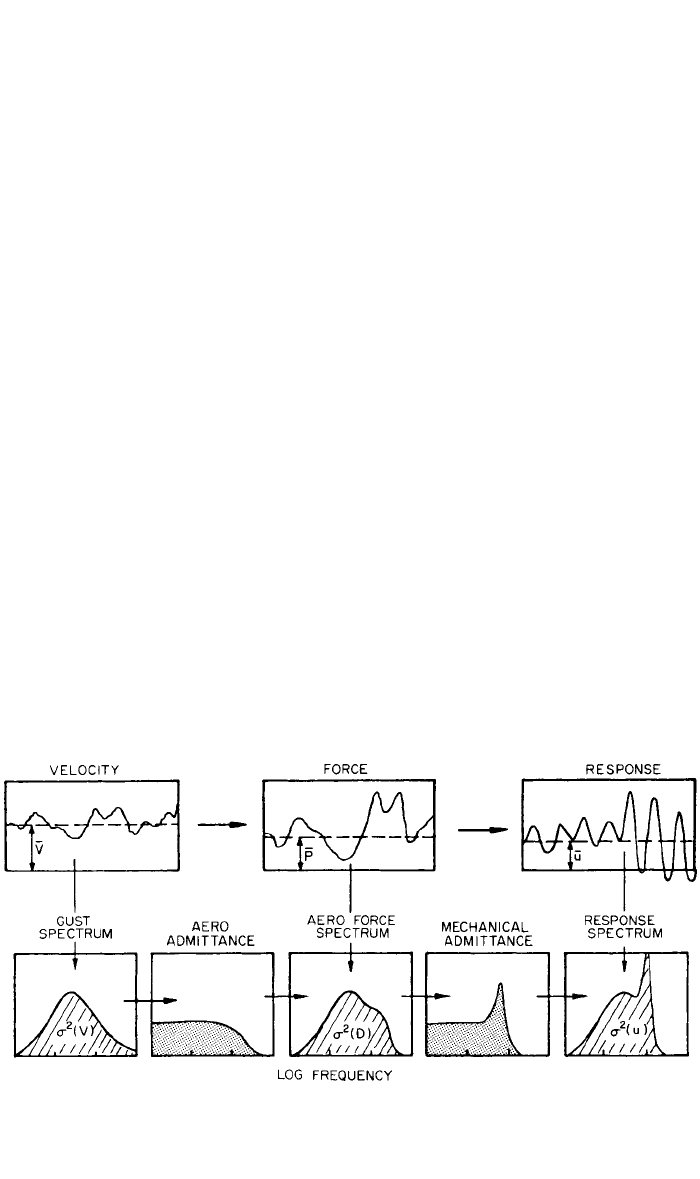
With large bodies, the wavelength is comparable to the size of the body itself
(that is, f
A
/
¯
V ≈ 1) and it is necessary to modify the drag spectrum by the so-called
aerodynamic admittance function |X
aero
(f )|
2
. This function
6
describes the modifying
influence of any changes in effective drag coefficient as well as the decrease in cor-
relation of the eddies as the wavelength of the eddies approaches the diameter of
the body. Thus, the modified drag spectrum is
= 4|X
aero
(f )|
2
If these forces act on an elastic spring-mass-damper system, the response of this
system u will have a spectrum
= |X
aero
|
2
|X
mech
|
2
where static deflection ¯u =
¯
D/k, k = stiffness constant, and the mechanical admittance
function is
|X
mech
|
2
=
where ζ=critical damping ratio, and f
n
= natural frequency of the system.
The transition from the spectrum of the wind-velocity fluctuations to the spec-
trum of the response is shown diagrammatically in Fig. 29.23. The variance of the
response σ
u
2
is obtained from the spectrum of the response,
σ
u
2
=
∞
0
W
u
(f ) df (29.30)
The relationships above describe the mean and the variance of the response. For
engineering purposes, it is also useful to define extreme values. It is often satisfactory
to assume that the process in question is Gaussian with probability density function
given by
1
[1 − (f/f
n
)
2
]
2
+ 4ζ
2
(f
2
/f
n
2
)
4W
v
(f )
¯
V
2
W
u
(f )
¯u
2
W
v
(f )
¯
V
2
W
D
(f )
¯
D
2
VIBRATION OF STRUCTURES INDUCED BY WIND 29.29
FIGURE 29.23 Transition from gust spectrum to response spectrum.
8434_Harris_29_b.qxd 09/20/2001 11:44 AM Page 29.29
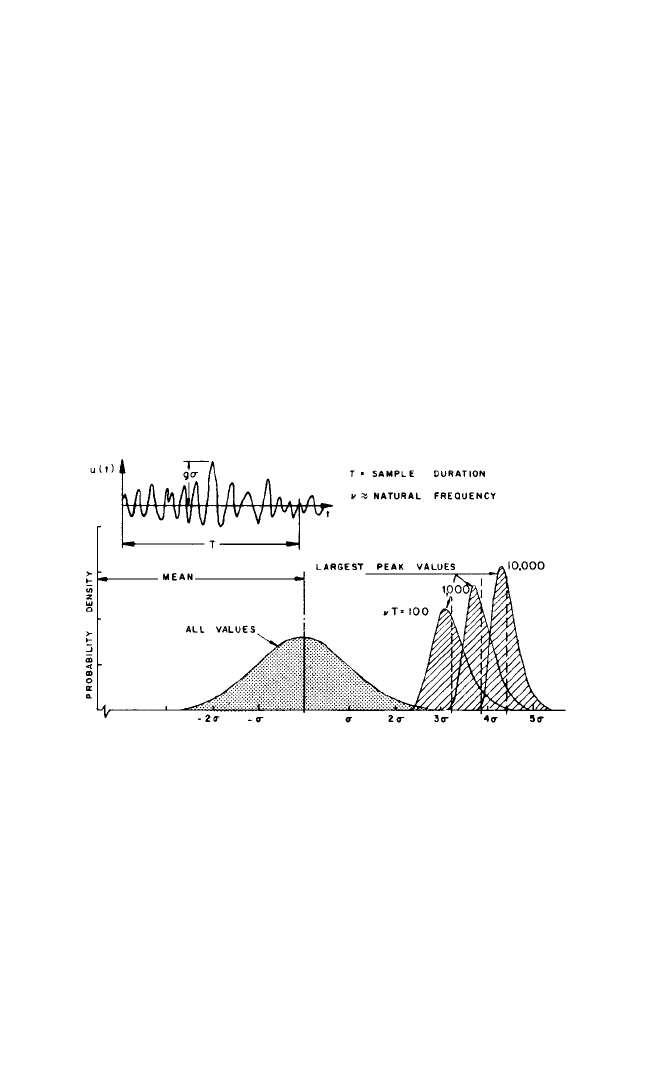
p(u) = e
−(u − ¯u)
2
/2σ
u
2
This distribution is fully described by the mean and the variance. Maximum values
of the response during time T can be written as
u
max
= ¯u + gσ
u
(29.31)
where g = peak factor.The average largest value of the peak factor in a period T can
be estimated from
6
g =
2
l
n
ν
T
+ (29.32)
where ν is an effective cycling rate of the process, generally close to the natural fre-
quency. The relationship of the distribution of the largest peak value to the distribu-
tion of all values is shown in Fig. 29.24. As can be seen, when the period T or the
natural frequency increases, the expected peak displacement also increases. The fac-
tor g usually ranges between 3 and 5.
0.5772
2
l
n
ν
T
1
2
π
σ
u
29.30 CHAPTER TWENTY-NINE, PART II
FIGURE 29.24 Relationship of distribution of largest peak value to dis-
tribution of all values (for a stationary random process).
Further extension of the concept includes the cross correlation of the wind loads
at different stations (e.g., heights), the shape of the vibration mode, and the nonuni-
formity of the mean flow. These factors can be included into the solution formulated
in terms of modal analysis (see Chap. 21). With a prismatic structure, the displace-
ment may be expressed in the form
u(z,t) =
∞
j = 1
q
j
(t)φ
j
(z) (29.33)
where q
j
(t) = the generalized coordinate of the jth mode, and φ
j
(z) = the jth mode of
natural vibrations to an arbitrary scale.
With damping small and natural frequencies well separated, the cross correlation
of the generalized coordinate can be neglected and the mean-square displacement
(the variance) is
8434_Harris_29_b.qxd 09/20/2001 11:44 AM Page 29.30
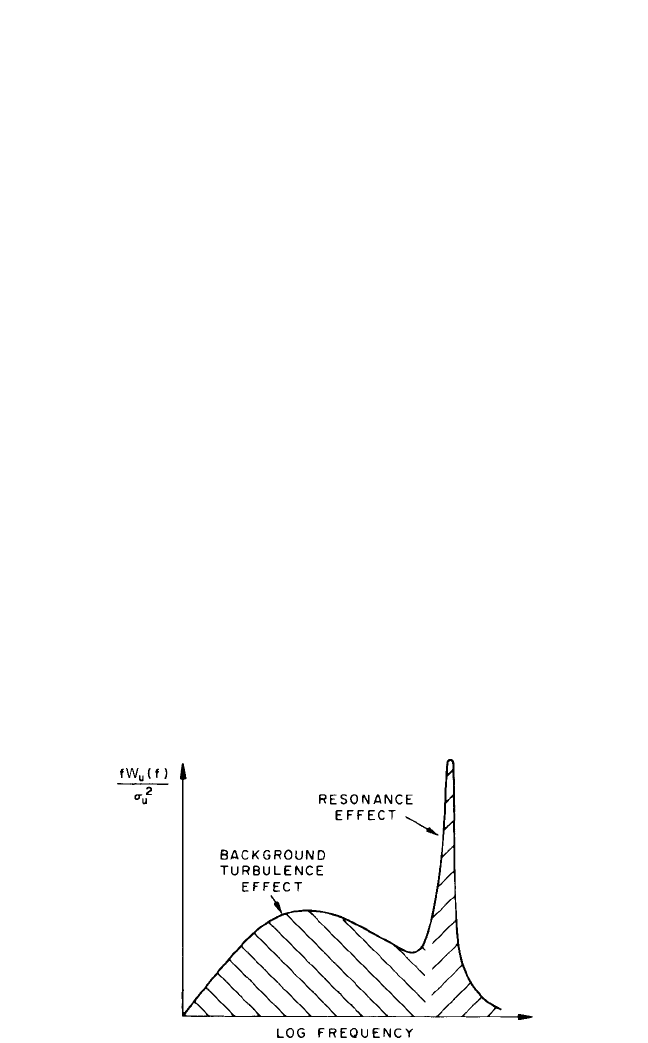
u
2
(
z
,
t
)
=
∞
j = 1
q
j
2
φ
j
2
(z) (29.34)
The variance of the generalized coordinate q
j
2
is determined by the power spectrum
of the generalized force Q
j
.When the lateral dimension of the structure is small, only
cross correlation in direction z need be considered. Then the power spectrum of the
generalized force is
W
Q
j
(f ) =
H
0
H
0
W
12
(z
1
,z
2
,f )φ
j
(z
1
)φ
j
(z
2
) dz
1
dz
2
(29.35)
where W
12
(z
1
,z
2
,f ) = cross spectrum of the wind loads at heights z
1
and z
2
, and
H = height of the structure. With respect to Eq. (29.28), the cross spectrum of the
wind loads can be expressed in terms of the power spectrum of the wind speed [Eq.
(29.25)] and the coherence function, Eq. (29.27).
The variance of q
j
is
q
j
2
=
∞
0
W
Qj
(f )
≈ W
Qj
(f
j
) +
f
j
0
W
Qj
(f ) df (29.36)
where f
j
= jth natural frequency and generalized mass
M
j
=
H
0
m(z)φ
j
2
(z) dz (29.37)
where m(z) = mass of the structure per unit length. The approximate integration
8
of
Eq. (29.36) yields the response composed of two parts, the resonance effect (the first
term) and the background turbulence effect (the second term), as shown in Fig.
29.25. The variance of the displacement follows from Eq. (29.34), and its standard
deviation (rms dynamic displacement) is σ
u
(z) =
u
2
(
z
,
t
)
. The peak response is
established from Eq. (29.31) by means of the peak factor g [Eq. (29.32)] as in one
degree-of-freedom.The mean deflection ¯u(z) is the static deflection due to the mean
wind
¯
V
z
.
1
(2πf
j
)
4
M
j
2
1
64π
3
ζf
j
3
M
j
2
1
[1 − (f/f
j
)
2
]
2
+ 4ζ
2
(f/f
j
)
2
1
(2πf
j
)
4
M
j
2
VIBRATION OF STRUCTURES INDUCED BY WIND 29.31
FIGURE 29.25 Spectrum of structural response with indication
of resonance effect and background turbulence effect.
8434_Harris_29_b.qxd 09/20/2001 11:44 AM Page 29.31

Other analyses of slender structures are also available.
9–11
In applications to
buildings and free-standing towers, the analysis can usually be limited to the first
modal component in Eq. (29.34).Application to buildings and structures with signif-
icant lateral dimension requires the incorporation of the horizontal cross correlation
as well. A complete solution established by means of simplifying assumptions and
numerical integrations is given below.
GUST-FACTOR APPROACH
The gust-factor approach is a design procedure derived on the basis of the theory
above by means of a few simplifying assumptions. The approach given here is a
modified version of the method described in Ref. 12 and adopted in Ref. 13. It con-
siders only the response in the first vibration mode which is assumed to be linear.
These assumptions are particularly suitable for buildings.The method yields all the
data needed in design: the maximum response, the equivalent static wind load that
would produce the same maximum response, and the maximum acceleration
needed for the evaluation of the physiological effects of strong winds (human
comfort).
The gust factor G is defined as the ratio of the expected peak displacement (load)
in a period T to the mean displacement (load)
u. Hence, the maximum expected
response is
u
max
= G¯u =
1 + g
¯u (29.38)
The gust factor is given as
G = 1 + g
B +
(29.39)
where ζ=damping ratio and K = factor related to the surface roughness; this factor
is equal to 0.08 for open terrain (zone A), 0.10 for suburban, urban, or wooded ter-
rain (zone B), and 0.14 for concentrations of tall buildings (zone C). All the other
parameters appearing in Eq. (29.39) can be obtained from Fig. 29.26. C
e
= exposure
factor based on the mean wind speed profile (coefficient α) and thus on surface
roughness. For the three zones, the exposure factor is obtained from Fig. 29.26A for
the height of the building H. C
e
relates to wind pressure rather than speed. Hence,
the mean wind speed at the top of the building is given by
¯
V
H
=
¯
V
10
C
e
where
¯
V
10
= reference wind speed at the standard height of 10 meters.
¯
V
10
can be
obtained from meteorological stations. Velocity
¯
V
H
is needed for determination of
parameters s and F. Factors B, s, F, and g are given in Fig. 29.26C to f as a function of
parameters indicated; D = width of the frontal area, and f
n
= the first natural fre-
quency of the structure in cycles per second.The average fluctuation rate ν, on which
the peak factor g depends, is evaluated from the formula
ν = f
0
(29.40)
sF/ζ
B + sF/ζ
sF
ζ
K
C
e
σ
u
¯u
29.32 CHAPTER TWENTY-NINE, PART II
8434_Harris_29_b.qxd 09/20/2001 11:44 AM Page 29.32
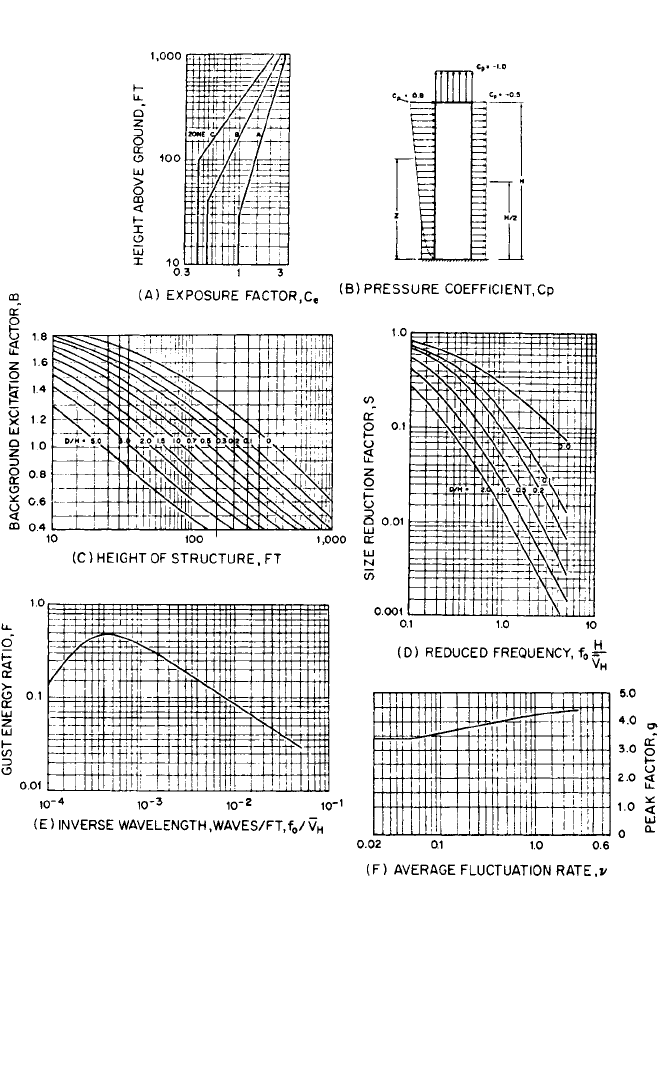
The peak factor g is plotted in Fig. 29.26F, assuming a period of observation T = 3600
sec; it can also be calculated from Eq. (29.32).
The parameters given also yield the design wind pressure p, which produces dis-
placement u
max
if applied as a static load. This design pressure
p = qC
e
GC
p
(29.41)
VIBRATION OF STRUCTURES INDUCED BY WIND 29.33
FIGURE 29.26 Components of gust factor.
8434_Harris_29_b.qxd 09/20/2001 11:44 AM Page 29.33

where q =
1
⁄2ρ
¯
V
10
2
is the reference mean-velocity pressure, and C
e
= exposure factor.
In this case, C
e
varies continuously with the elevation according to Fig. 29.26A for
pressures acting on the windward face of the structure; for the leeward face, C
e
is
constant and evaluated at one-half the height of the building.The quantity C
p
= aver-
age pressure coefficient, which depends on the shape of the structure and the flow
pattern around it. For a typical building with a flat roof and a height greater than
twice the width, the coefficients are given for the windward and leeward faces in Fig.
29.26B together with the pressure distribution.
The peak acceleration A of a structure due to gusting wind is given by
A = u
max
where u
max
= maximum deflection under the design pressure p. The other parameters
are equal to those used in Eq. (29.39). When the acceleration exceeds about 1 per-
cent of gravity, the motion is usually perceptible. However, there are large differ-
ences in the perceptibility of motions having very low frequencies.
14,15
Similar
approaches are given in Refs. 16 to 18.
EFFECT OF GUSTS ON CLADDING AND WINDOWS
Wind gusts produce local pressures on cladding and window panels of a building.
Because the natural frequency of such a panel is very high compared with the fre-
quency components of the wind-speed fluctuations, the panel displacement is essen-
tially static. Its design may be based on the static displacement resulting from
maximum expected pressure, which is the algebraic sum of the height and time-
dependent exterior pressure (or suction) and the constant interior pressure (or suc-
tion). If the fluctuating component of the pressure p(t) is considered to be a
stationary random process, the exterior expected maximum pressure is
p
max
= ¯p
1 + g
= ¯pG (29.42)
where ¯p =
1
⁄2ρC
p
¯¯
V
2
= mean pressure
C
p
= local pressure coefficient
σ
p
= standard deviation of the fluctuating pressure component
g = peak factor given by Eq. (29.32)
G = gust factor
To account for the sensitivity of glass to both static and dynamic fatigue, it has been
suggested
19, 20
that g or G in Eq. (29.42) be multiplied by a wind-on-glass effect factor.
Factors g, σ
p
/¯p, and C
p
are most reliably determined from wind-tunnel experi-
ments. They strongly depend on location of the panel, wind direction, turbulence
intensity, and the local flow pattern determined by the shape of the building and its
immediate environment. In full-scale experiments, values of g in excess of 10 have
been observed in highly intermittent flow. Largest local pressure coefficients C
p
(actually suctions) appear with skew wind at the leading edge of the building where
a typical value is C
p
=−1.5. In that part of the building exposed to free flow, a gust
factor G ≈ 2.5 is a reasonable estimate.
13, 21
The interior pressure is not very high, but
its magnitude and sign depend on openings and leakage.
σ
p
¯p
KsF
C
e
ζ
4π
2
f
0
2
g
G
29.34 CHAPTER TWENTY-NINE, PART II
8434_Harris_29_b.qxd 09/20/2001 11:44 AM Page 29.34

Damage to windows may result from local wind pressure, but it also depends on
material properties of glass and its fatigue. The fatigue limit of glass is only about 20
percent of the instantaneous strength.
20
VIBRATION DUE TO VORTEX SHEDDING
Vortex shedding represents the second most important mechanism for wind-
induced oscillations. Unlike the gusts, vortex shedding produces forces which origi-
nate in the wake behind the structure, act mainly in the across-wind direction, and
are, in general, rather regular. The resultant oscillation is resonant in character, is
often almost periodic, and usually appears in the direction perpendicular to that of
the wind. Lightly damped structures such as chimneys and towers are particularly
susceptible to vortex shedding. Many failures attributed to vortex shedding have
been reported.
When a bluff body is exposed to wind, vortices shed from the sides of the body
creating a pattern in its wake often called the Karman vortex street (Fig. 29.16). The
frequency of the shedding, nearly constant in many cases, depends on the shape and
size of the body, the velocity of the flow, and to a lesser degree on the surface rough-
ness and the turbulence of the flow. If the cross section of the body is noncircular, it
also depends on the wind direction. The dominant frequency of vortex shedding f
s
is
given by
f
s
= S
¯
Hz (29.43)
where S = dimensionless constant called the Strouhal number,
¯
V = mean wind veloc-
ity, and D = width of the frontal area. The second dimensionless parameter is the
Reynolds number R =
¯
VD/ν, where ν = kinematic viscosity. For air under normal
conditions, ν = 1.6 × 10
−4
ft
2
/sec.
For a body having a rectangular or square cross section, the Strouhal number is
almost independent of the Reynolds number. For a body having a circular cross sec-
tion, the Strouhal number varies with the regime of the flow as characterized by the
Reynolds number. There are three major regions: the subcritical region for R
3 ×
10
5
, the supercritical region for 3 × 10
5
R
3 × 10
6
, and the transcritical region for
R
3 × 10
6
. Approximate values of the Strouhal number for typical cross sections
are given in Table 29.2. The numbers given in this table are based on Refs. 1, 22, 23,
and 24 and other measurements, and may be used for turbulent shear flow.
PREDICTION OF VORTEX-INDUCED OSCILLATION
Although the mechanism of vortex shedding and the character of the lift forces have
been the subject of a great number of studies,
25
the available information does not
permit an accurate prediction of these oscillations. The motion is most often viewed
as forced oscillation due to the lift force, which, per unit length, may be written as
F
L
=ρD
¯
V
2
C
L
(t) (29.44)
1
2
V
D
VIBRATION OF STRUCTURES INDUCED BY WIND 29.35
8434_Harris_29_b.qxd 09/20/2001 11:44 AM Page 29.35
